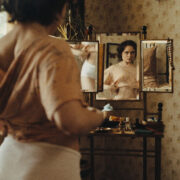In the Realm of the Senses: Pretentious Pornography? Or Something More
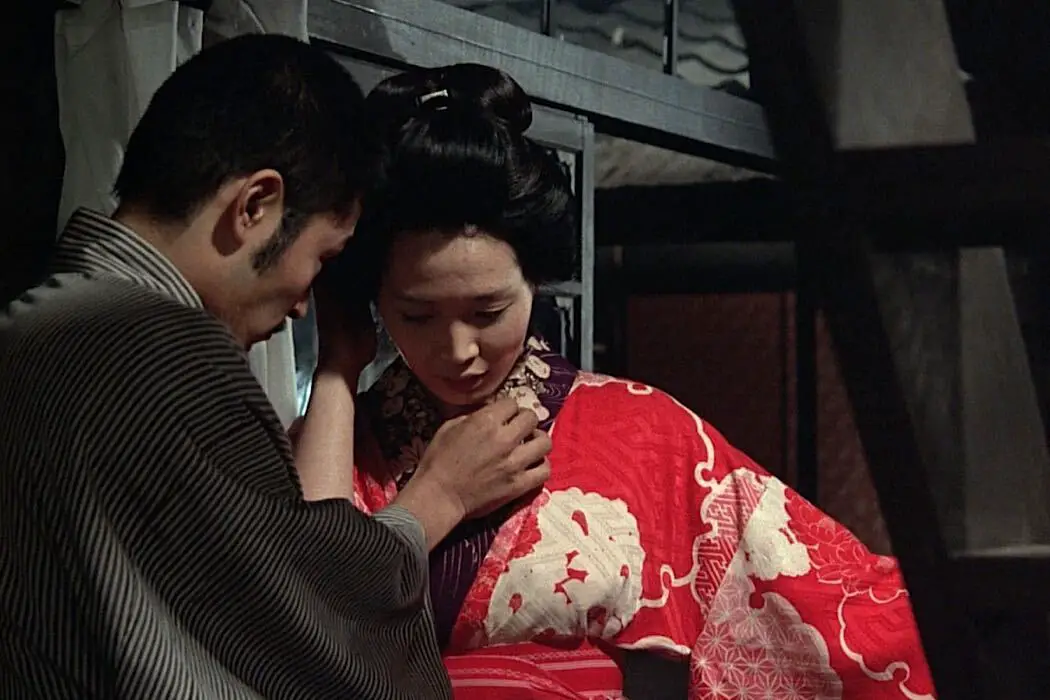
If there is one word that can sum up Dallas…
Words shall not be minced here–I have a love-hate relationship with this movie. On the one hand, the late and great Nagisa Oshima crafted this film, and to readers of mine, the name should be familiar. A year ago, I wrote an analysis of his beloved yuletide-themed movie, Merry Christmas Mr. Lawrence, and since then, it has become one of my favorite films. Flash forward to the present, and I decided to give his most controversial and highly acclaimed film, In the Realm of the Senses, a viewing.
When it was all said and done, I could not gather the proper thoughts to gauge how I felt about this film. I rewatched it, mentally deliberated it in the courtroom of my mind, and watched it again. And each time I pushed play, I felt equal parts exhilarated, intrigued, and, in all frankness, disgusted. But then again, I believe that is the point Oshima was trying to make. There is a lot to unpack here, so without further ado, here is a deep dive into In the Realm of the Senses.
The Strange and Horrid Case of Sada Abe
Sada Abe was a former prostitute born May 28, 1905, to a humble family of Tatami Mat makers in Tokyo. Abe’s childhood was tumultuous. Her early childhood was somewhat idyllic, and she is said to have had a mother who doted on her and a father who was considered an upstanding and good man in his community. Abe was even encouraged by her mother to partake in lessons with the traditional Japanese instrument, the shamisen.
The shamisen, at the time, was an instrument most often associated with geishas–fancy female hosts who are well-versed in music, the arts, and conversation. A western equivalent to a geisha could be a courtesan, although not all geisha engage in sexual activity with their clients. Abe associated herself with several geisha who saw promise in the young girl because she had an affinity with the shamisen. This is where Abe’s life takes a turn for the tragic.
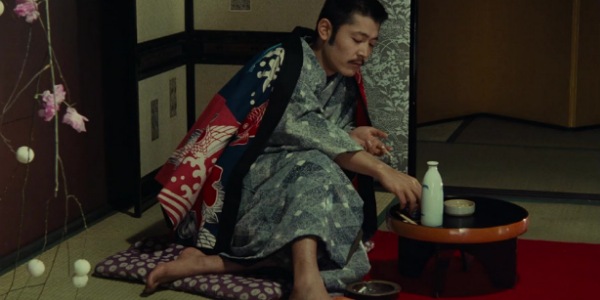
She was reported to have skipped school, become a truant, and been associated with several other troubled girls. Financial troubles began to arise in the Abe household, with Abe’s brothers and sisters having their problems. At fourteen, Sada Abe was raped by an acquaintance, a local college student. Abe’s parents did their best to press charges, but Abe’s delinquent behavior made matters worse for the family, and as money troubles began to get worse, she was forced to leave home and was subsequently sold to a geisha house in Yokohama in 1922.
Sada Abe’s geisha career was disappointing, never garnering the clients she wished she could obtain and developing the reputation of being a troublemaker. Abe was caught on several occasions stealing money from clients and getting into fights, and down the road, Abe left the geisha world and opted for a life of prostitution to make money. She soon left sex work and, in an attempt to shield herself from her sordid past, became a maid at an establishment called Yoshida Inn in Tokyo. That is where she met her soon-to-be boss/lover Kichizo Ishida and the two of them enter a passionate and, ultimately dangerous, love affair.
Long story short, as the affair between Abe and Ishida becomes more desperate, Abe strangles her lover in a fit of jealousy and then severs his penis. With the severed member in her purse, she travels about Tokyo in a daze until police apprehend her on May 20th, 1936and, arresting her for murder and mutilation of a body. What makes this story even grimmer than it already is is the message in Ishida’s blood written on his chest by Abe, which states, “We, Sada and Kichizo Ishida, are alone.” This entire debacle, the whole sordid affair, is the focal point of In the Realm of the Senses, the 1976 erotic drama by Nagisa Oshima, and to this day, still shock audiences worldwide.
Here come the cheers
Since before I cast any stones, I would like to discuss what makes this film stand out. First is the cinematography; In the Realm of the Senses is a gorgeous film. The coloring pops, refraining from the grainy and muddied tones of several films from the seventies, which look like the celluloid prints were smeared in vaseline. Every red is amplified to a bright and vibrant crimson glory; black tones sheen and seems at times to be like a beautiful abyss; and any other shade or hue of color is made to look more magnificent than it truly is. In the Realm of the Senses is a technicolor feast for the eyes.
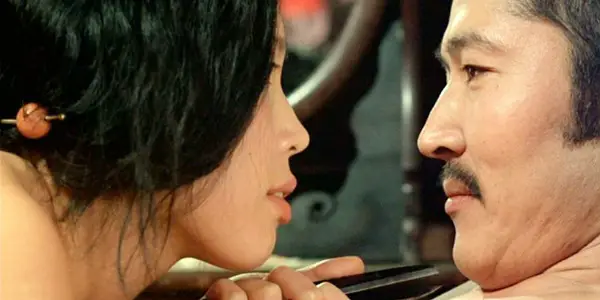
Another praise for cinematography I have for this feature is the striking and effective use of camera angles and shots that ooze with an unforgettable punch. An example is in order, and there is one scene where Sada goes through an episode of sexual hysteria, lost in her lust, consumed in the whirlwind of her sexual deviancy with no recourse or means to assuage it. Oshima extrapolates on this flurry of feelings by showcasing her stark naked on a platform next to a series of chairs in an empty stadium–a woman craving touch, wishing for others to notice her. The choosing of an open public area, panting and moaning accompanied by nothing but a minimal plucking of a shamisen (the instrument she grew up playing) as the background music and then dead silence with only her madness to fill the space–is a striking use of tone and character development.
Speaking of music, the score for In the Realm of the Senses is one of the best for utilizing traditional Japanese music. I sometimes find myself playing the soundtrack as I go for walks, admiring the world around me in a melancholy kind of way. I am a sucker for film scores, and this one has become one of my favorites. Minoru Kichi is known for his compositions utilizing traditional Asian instrumentation from Japan, China, and Korea. Regarding his musical work outside of film scores, he was a classically trained orchestral musician who was one of the best-known Japanese composers outside his country. I say “was” because he, unfortunately, died of sepsis on December 8th, 2011. The maestro shall be missed.
The tertiary cheer I have for this film is its most controversial point: the use of unsimulated sex between all actors. Yes, In the Realm of the Senses is unique in mainstream film erotica due to its unsimulated sex scenes. Oshima wanted to implement that controversy to make a point not just about how art is made but about Japanese society as a whole (as Oshima was notorious for) and its weird views on sexual censorship.
For a long time, Japan has had some hardcore pornography and erotic films that bluntly showcase sexuality. However, what sets it apart as a nation that produces such media is its outdated insistence that all genitalia be blurred out. This baffles many a foreign audience who enjoy consuming Japanese erotic material. While the history behind such censorship may be too extensive for this feature alone, the important thing is that Nagisa Oshima wanted to test this boundary. Not only does he insist that all of the actors included partaking in actual sex for all of the spicy scenes, but there is no blurring of the genitals that is common with Japanese pornography.
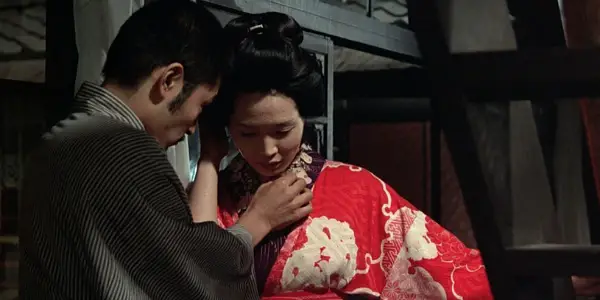
To me, this is a bold move and is the perfect indictment of the hypocrisy of Japanese censorship. In an earlier feature, I wrote about Urotsukidoji: Legend of the Overfiend and how it bypassed censorship by utilizing monsters with tentacles instead of human males with actual penises. So it is apparent that Japan is a-ok with monster rape, but human sexuality, where the genitalia is blurred as if it was something shameful, must be stopped at all costs! When the Japanese film board questioned why he made In the Realm of the Senses in such a shameless manner, Oshima himself retorted: “Nothing that is expressed is obscene. What is obscene is what is hidden,”
Leave it to a leader of the new wave of Japanese cinema to stick it to the proverbial man. There is also something about the authenticity of the passion and downright sexual desperation of the characters in question when they engage in actual sexual intercourse that would seem lacking if the sex was simulated. In the view of Oshima, through his lens and thought process, sex is only dirty when one makes it dirty. By censoring it, the appeal is only heightened. After all, when you make something forbidden, even if it is a cursory blurring of the sexual parts, you increase your desire to see more, thus making censorship moot.
Now for the jeers
Now, after heaping some praise upon Oshima’s work, it is time for the proverbial bandaid to be ripped from the skin of this film. I cannot, in good conscience, say that this is a good exploration into proposed themes of repression, sexual angst, or even the underlying theme of wartime aggression that so many others have said it is. In the Realm of the Senses has been lauded as an essential work in transgressive cinema, erotica, and a masterwork in a scathing commentary on the growth of madness in 1930s Japan. I have to disagree humbly.
While something is to be said about the film’s ability to shock and awe the audience into “possibly” examining the themes above, In the Realm of the Senses left me (no pun intended) limp. Take, for example, Oshima’s later work, Merry Christmas Mr. Lawrence, which tackled themes of repression and the madness of nationalism with more significant effect–particularly in how it handles its characters, both the protagonists and antagonists. Even the antagonists were given moments of humanity, or the viewer–unable to agree with their questionable actions–could at least see how they would have been driven down the path of aggression, repression, and jingoistic insanity. There was an earnest attempt to bring humanity to the enemy even if, for the story, the main protagonists and their plight were the natural groups we should sympathize with and feel the fondest for.
In the Realm of the Senses, whether I imagine this, does not attempt to make the supposed protagonists–the very ones we should feel the most sympathy for–as objectionable as possible. To be fair, this film is based upon real-life accounts of a series of deranged people with feverish minds, but when in the right hands, even a character in a movie that is sure to raise many eyebrows can at least be understood as to why they are the way they are. This is a disappointment for a director like Nagisa Oshima, who has shown in predecessive and successive films to handle this character writing aspect well.
To put it bluntly, Sada and Ishido are one of the worst couples to be put in erotica, let alone acting as romantic leads. Ishido enters the relationship with Sada through an act tantamount to molestation (even if she seemingly welcomes it, albeit reluctantly), and Sada becomes more disgusting as time passes. This would not be the biggest of problems if the characters were written in a way that makes them intentionally deplorable to the audience. Still, I cannot shake the feeling that the audience is supposed to feel sympathy for the pair. But, on the other hand, maybe that is the point. After all, the real Sada Abe not only captured the collective morbid imagination of the Japanese public at the time of her incarceration but had many who defended her at the time. Maybe Oshima wanted to put the mirror up at the audience to show us our willingness to get wrapped in media hype, just like the Japanese public felt sorry for the twisted couple at the time. Could it be that Oshima was trying to point out the absurdity of such a case? You can be the judge, but I cannot see it.
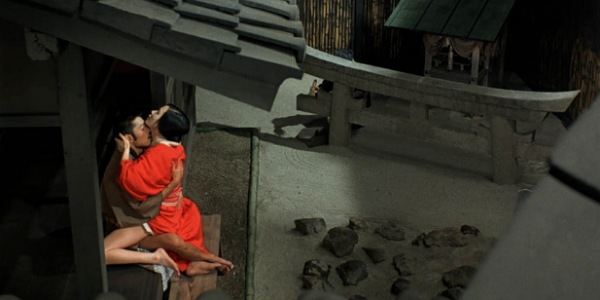
There are also scenes within the film that make no sense in the greater context of Sada and Ishida’s ever-growing destructive relationship. One such scene, in particular, is equally perplexing and disturbing since it is a gratuitous display of child abuse. The scene is Sada playing with two little children, a boy and a girl, singing a playful Japanese folk song two them as they run around her, naked and giggling. The scene would be charming in its way if it not for the fact that the little boy, when he gets too rowdy for her liking, Sada grabs him by his genitals as a punishment as he says, “it hurts! it hurts!” over and over again–end scene. The poor child, and considering what I mentioned earlier about simulation, it makes the shot seem all the more disagreeable. What was the point of this scene? Why would she do something like that to an innocent child? Was there a more significant point that Oshima was trying to make, some commentary? You can draw your conclusion, but I do not grasp it.
Some detractors towards me might argue that this represents Japan as a growing nation that needs to be wrangled in by a parental figure–i.e., the Imperial Japanese government. That argument is flimsy at best since there are clues in the movie showing that Japan is about to explode with nationalistic and militaristic fervor; they pass by too quickly to make an impact. The only scene showing Japan rising in its burgeoning authoritarianism is when Ishida returns from his local barber. A troop of militia men marches in lockstep past him as many children wave Japanese flags.
Oshima, Please Extrapolate!
Suppose Oshima was able and or willing to showcase more of the oppressive government of Imperial Japan encroaching and impeding upon the lives of its citizens. In that case, the extreme behavior of Sada and Ishida might have made more sense. Then, there would be more reasons why the two of them not only felt more alienated from society but their pent-up rage and sorrow would be more palpable and might add to the viewers’ sympathy for their plight. Feeling trapped by society is a universal feeling, and no doubt the real Sada and Ishida were feeling the weight of a dictatorship upon their shoulders, as did many Japanese citizens at the time–but they would not dare utter a word against their lords.
Since the film was set in 1936, a historical context would have been appreciated, and more than a simple scene of soldiers marching through a street is needed. Japan, at the time, was at a boiling point of planning to invade as many Asian territories as possible. It was also the year before they joined an alliance with Germany and Italy, thus forming the Axis Powers. Why Oshima did not delve deeper into such a pivotal point in Japanese history–primarily since he was known for his razor-sharp wit when digging the proverbial knife into his culture’s shortcomings–is beyond me.
Isolation from society is nothing new for Oshima, whether it is the guilt-ridden conflicts of Captain Yanoi from Merry Christmas Mr. Lawrence; the plights of Koreans living in Japan in his film Death By Hanging, or the angsty lovesickness of homosexual samurai in Gohatto–Oshima knows how to write outsiders and their pain of feeling disaffected in some way by society at large. But what I see within In the Realm of the Senses is less discussion about alienation and what it does to the human psyche juxtaposed with the problems of traditional Japanese culture, but more of an excuse to wallow in the depravity of its main leads.
Eroticism is also a staple of Oshima’s body of work, but he allows breathing room in his other works to allow characters to grow. There were times when I just wanted Sada and Ishida to stop their non-stop sexual escapades that unfold in extremity too, I don’t know, talk about themselves. Maybe the viewers would sympathize more with their isolation from the world around them. This is not the writing of a prude or anyone who finds erotica distasteful. Since it is germane to the topic, I am willing to do something outside of the norm and suggest another film that handles erotica between two lonely and kindred spirits better.
Recommendations and conclusions
It must be recognized that while In the Realm of the Senses is not my cup of tea, it is still considered by many to be a pivotal work in erotica. With that said, I believe there are better recommendations in the genre that are worth checking out more, and one of those is a movie called, The Duke of Burgundy, a film about two women in a sadomasochistic relationship. But unlike In the Realm of the Senses, where the sexuality is taken to an uncomfortable fever pitch, The Duke of Burgundy takes a more psychological approach to its sexuality. He makes it something more beautiful, lacking the desperation of Oshima’s work. There are so many themes in The Duke of Burgundy worth exploring that, who knows, I will probably write a feature on that film. For those who enjoy the erotica genre, I believe it is worth watching more than the bloviated In the Realm of the Senses.
All in all, In the Realm of the Senses, is a beautiful-looking film with a calming yet haunting score and does attempt to touch on some urgent themes of repression and alienation, but it falls short overall. It is the victim of its over-the-top eroticism, lacking the depth of Nagisa Oshima’s other films, which explored some of the themes of In the Realm of the Senses with more care and universal appeal. Maybe I am wrong or need to look at this film from a different perspective–who knows. I know it will be a while until I dive back into Sada and Ishido’s sordid and deadly affair.
Trailer:
Does content like this matter to you?
Become a Member and support film journalism. Unlock access to all of Film Inquiry`s great articles. Join a community of like-minded readers who are passionate about cinema - get access to our private members Network, give back to independent filmmakers, and more.
If there is one word that can sum up Dallas Marshall, it would be weird. He is a strange fellow who is also a writer, anime nerd, and film buff who can also talk for hours about mythology and out-there literature. He has been sighted at local used bookstores perusing for horror books and manga. He has also written a book about Japanese animation called Anime Adrenaline! Which can be found on Amazon. You can also catch him on his own website at www.Dallasthewriter.com











